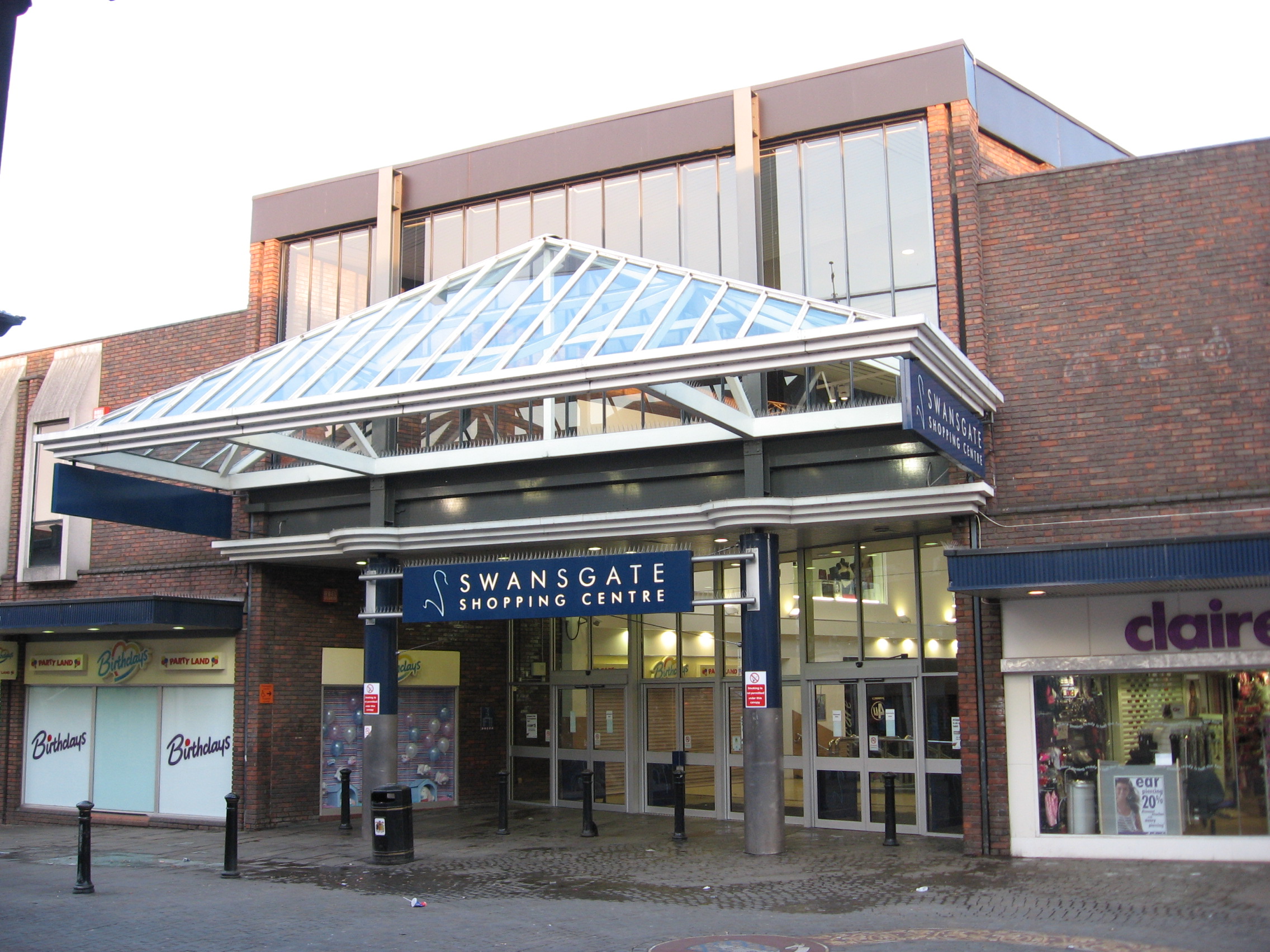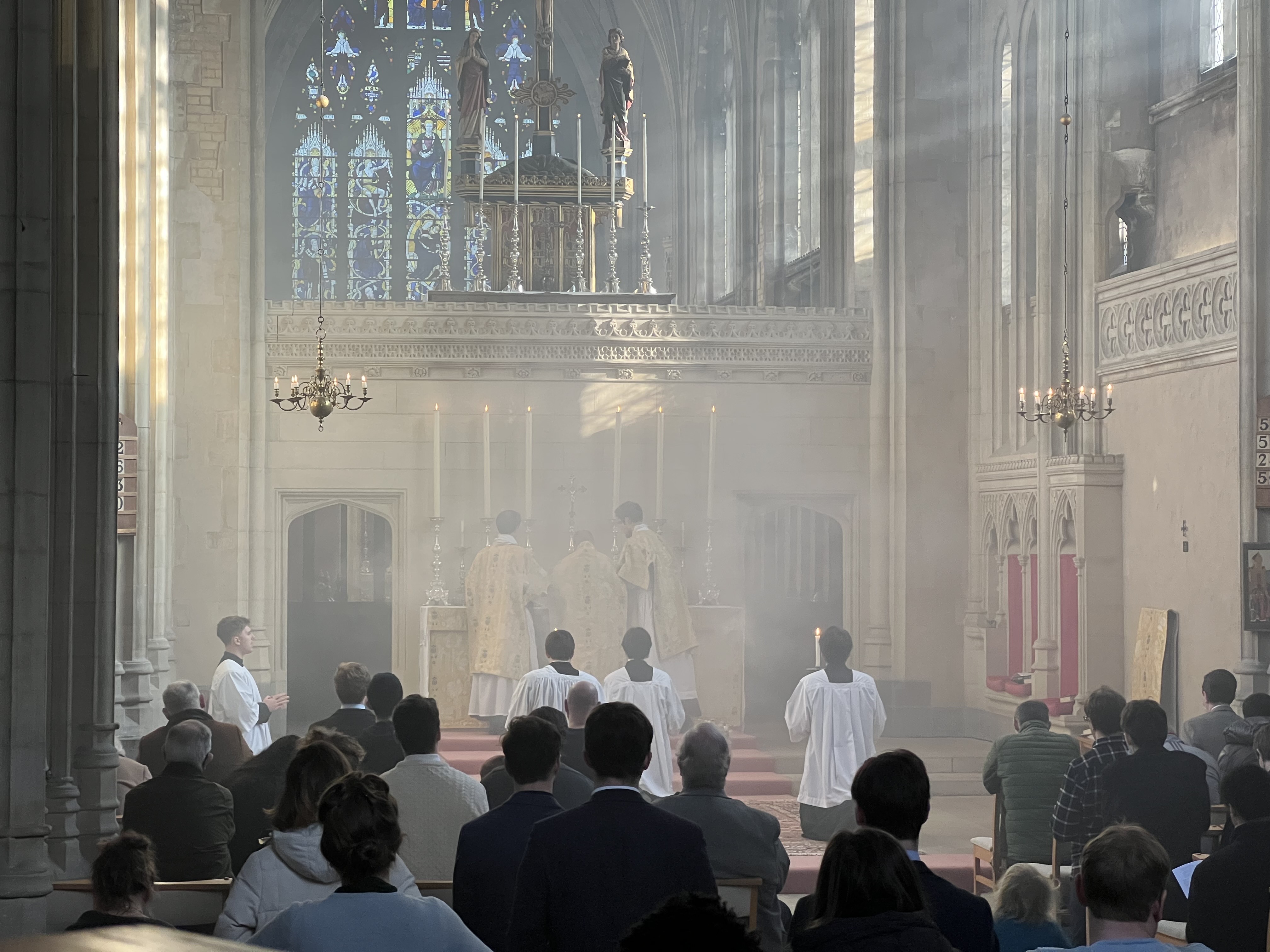|
Church Of St Mary The Virgin, Wellingborough
The Church of St Mary the Virgin is a Church of England parish church in Wellingborough, Northamptonshire. The church is a Grade I listed building. History The church was built from 1908 to 1930, and was designed by Sir Ninian Comper. It is in the Perpendicular Gothic style. The design and interior of the church was influenced by the Oxford Movement and the Victorian revival of ritualism Financing of the work was largely due to the Misses Sharman of Wellingborough. On 9 June 1970, St Mary's Church was designated a Grade I listed building. It is one of only a few Grade I listed buildings built in the 20th century. Present day The parish of St Mary the Virgin Wellingborough is in the Archdeaconry of Northampton in the Diocese of Peterborough. St Mary's stands in the Anglo-Catholic tradition of the Church of England. As the parish has passed a resolution to reject the ordination of women, it receives alternative episcopal oversight from the Bishop of Richborough. It is also a ... [...More Info...] [...Related Items...] OR: [Wikipedia] [Google] [Baidu] |
Wellingborough
Wellingborough ( ) is a market town in the North Northamptonshire, Unitary Authority area, England, from London and from Northampton, north of the River Nene. Originally named "Wendelingburgh" (the stronghold of Wændel's people), the Anglo-Saxon settlement is mentioned in the Domesday Book of 1086 as "Wendelburie". The town's market was granted a royal charter in 1201 by John of England, King John. At the 2021 census, it had a population of 56,564. The built-up area also includes suburbs Wilby, Northamptonshire, Wilby, Great Doddington, Little Irchester, Redhill Grange, Stanton Cross, Waendel View and Glenvale Park. History The town was established in the History of Anglo-Saxon England, Anglo-Saxon period and was called "Wendelingburgh". It is surrounded by five wells: Redwell, Hemmingwell, Witche's Well, Lady's Well and Whytewell, which appear on its coat of arms. Henrietta Maria, the Queen Consort of King Charles I of England, Charles I, came with her physician Théodor ... [...More Info...] [...Related Items...] OR: [Wikipedia] [Google] [Baidu] |
Grade I Listed Modern Buildings In England
In England buildings of particular architectural merit and/or historic significance are given statutory protection under the listed buildings scheme. The scheme categorises buildings in three grades; Grade I, the highest grade, Grade II*, and Grade II, the lowest grade. Approximately 500,000 buildings in England have listed building status, the vast majority at Grade II. Decisions on listing are made by the Secretary of State for Culture, Media and Sport, on advice from Historic England, the agency with responsibility for the historic environment. Decisions on listing are closely related to the age of the building. Buildings constructed before 1700 will almost certainly be listed and many constructed between 1700 and 1850 will be. Construction dates between 1850 and 1945 will reduce the likelihood of listing, and even greater selectivity is exercised for Post-war Britain (1945–1979), post-war buildings. There is a presumption against listing buildings that are less than 30 years ... [...More Info...] [...Related Items...] OR: [Wikipedia] [Google] [Baidu] |
Anglo-Catholic Church Buildings In Northamptonshire
Anglo-Catholicism comprises beliefs and practices that emphasise the Catholic heritage (especially pre-Reformation roots) and identity of the Church of England and various churches within Anglicanism. Anglo-Catholicism claims to restore liturgical and devotional expressions of church life that reflect the ancient practices of the early and medieval church. The term was coined in the early 19th century, although movements emphasising the Catholic nature of Anglicanism already existed. Particularly influential in the history of Anglo-Catholicism were the Caroline Divines of the 17th century, the Jacobite Nonjuring schism of the 17th and 18th centuries, and the Oxford Movement, which began at the University of Oxford in 1833 and ushered in a period of Anglican history known as the "Catholic Revival". History The historic Anglican formularies, developed under the influence of Thomas Cranmer, include the '' Thirty-nine Articles of Religion'' and ''The Books of Homilies'', both ... [...More Info...] [...Related Items...] OR: [Wikipedia] [Google] [Baidu] |
Grade I Listed Churches In Northamptonshire
Grade most commonly refers to: * Grading in education, a measurement of a student's performance by educational assessment (e.g. A, pass, etc.) * A designation for students, classes and curricula indicating the number of the year a student has reached in a given educational stage (e.g. first grade, second grade, K–12, etc.) * Grade (slope), the steepness of a slope * Graded voting Grade or grading may also refer to: Music * Grade (music), a formally assessed level of profiency in a musical instrument * Grade (band), punk rock band * Grades (producer), British electronic dance music producer and DJ Science and technology Biology and medicine * Grading (tumors), a measure of the aggressiveness of a tumor in medicine * The Grading of Recommendations Assessment, Development and Evaluation (GRADE) approach * Evolutionary grade, a paraphyletic group of organisms Geology * Graded bedding, a description of the variation in grain size through a bed in a sedimentary rock * Metamorphic ... [...More Info...] [...Related Items...] OR: [Wikipedia] [Google] [Baidu] |
Church Of England Church Buildings In Northamptonshire
Church may refer to: Religion * Church (building), a place/building for Christian religious activities and praying * Church (congregation), a local congregation of a Christian denomination * Church service, a formalized period of Christian communal worship * Christian denomination, a Christian organization with distinct doctrine and practice * Christian Church, either the collective body of all Christian believers, or early Christianity Places United Kingdom * Church, a former electoral ward of Kensington and Chelsea London Borough Council that existed from 1964 to 2002 * Church (Liverpool ward), a Liverpool City Council ward * Church (Reading ward), a Reading Borough Council ward * Church (Sefton ward), a Metropolitan Borough of Sefton ward * Church, Lancashire, England United States * Church, Iowa, an unincorporated community * Church Lake, a lake in Minnesota * Church, Michigan, ghost town Arts, entertainment, and media * '' Church magazine'', a pastoral theology maga ... [...More Info...] [...Related Items...] OR: [Wikipedia] [Google] [Baidu] |
Priest In Charge
A priest in charge or priest-in-charge (previously also curate-in-charge) in the Church of England is a priest in charge of a parish who is not its incumbent; they will normally work on a short-term contract and have less freedom to act within the parish. Such priests are not legally responsible for the churches and glebe, but simply hold a licence rather than the freehold and are not appointed by advowson. Under the legislation of the Church of England, the process for a bishop to remove a priest-in-charge is relatively straightforward. As a result, the appointment of priests in charge rather than incumbents (one who does receive the temporalities of an incumbent) is sometimes done when parish reorganisation is taking place or to give the bishop greater control over the deployment of clergy. Legally, priests in charge are '' temporary curates'', as they have only spiritual responsibilities. Even though they lead the ministry in their parishes, their legal status is little dif ... [...More Info...] [...Related Items...] OR: [Wikipedia] [Google] [Baidu] |
The Society (Church Of England)
The Society may refer to: * The Society (Church of England), an independent association of Church of England clergy and lay people * ''The Society'' (TV series), a 2019 series on Netflix * The Society (ex Danse Society), a gothic rock band * "The Society" (''The Amazing World of Gumball''), a 2015 TV episode See also * Society (other) {{disambiguation ... [...More Info...] [...Related Items...] OR: [Wikipedia] [Google] [Baidu] |
Forward In Faith
Forward in Faith (FiF) is an organisation operating in the Church of England and the Scottish Episcopal Church. It represents a traditionalist strand of Anglo-Catholicism and is characterised by its opposition to the ordination of women to the priesthood and episcopate. It also takes a traditionalist line on other matters of doctrine. Credo Cymru is its counterpart in Wales. Forward in Faith North America (FIFNA) operates in the U.S. History FiF was formed in 1992 in response to approval by the General Synod of the Church of England of the ordination of women to the priesthood, initially an umbrella body for a number of Catholically oriented societies and campaigning groups. It became a membership organisation in 1994 and was registered as a charity in 1996. The traditionalist group in the Scottish Episcopal Church joined forces with Forward in Faith in 1997. Credo Cymru, the traditionalist body in the Church in Wales, established formal links with Forward in Faith in 2003; the two ... [...More Info...] [...Related Items...] OR: [Wikipedia] [Google] [Baidu] |
Bishop Of Richborough
The Bishop of Richborough is a suffragan bishop and provincial episcopal visitor for the whole of the Province of Canterbury in the Church of England. Since 2025, Luke Irvine-Capel has served as Bishop of Richborough. History The see was erected under the Suffragans Nomination Act 1888 by Order in Council dated 8 February 1994 and licensed by the Archbishop of Canterbury as a " flying bishop" to provide episcopal oversight for parishes throughout the province which cannot in good conscience accept the sacramental ministry of bishops who have participated in the ordination of women. The title takes its name from Richborough, a settlement north of Sandwich in Kent. In the southern province, the bishops of Ebbsfleet and of Richborough each minister in 13 of the 40 dioceses. The Bishop of Richborough serves the eastern half ( Canterbury, Chelmsford, Chichester, Ely, Guildford, St Edmundsbury & Ipswich, Leicester, Lincoln, Norwich, Peterborough, Portsmouth, St Alban ... [...More Info...] [...Related Items...] OR: [Wikipedia] [Google] [Baidu] |
Alternative Episcopal Oversight
A provincial episcopal visitor (PEV), popularly known as a flying bishop, is a Church of England bishop assigned to minister to many of the clergy, laity and parishes who on grounds of theological conviction "are unable to receive the ministry of women bishops or priests". The system by which such bishops oversee certain churches is referred to as alternative episcopal oversight (AEO). History The Church of England ordination, ordained its first women priests in 1994. According to acts of the General Synod of the Church of England, General Synod passed the previous year (Priests (Ordination of Women) Measure 1993), if a parish does not accept the ministry of women priests it can formally request that none be appointed to minister to it. Via the ''Episcopal Ministry Act of Synod 1993'', if the local bishop has participated in the ordination of women as priests, a parish can request to be under the pastoral and sacramental care of another bishop who has not participated in such ordin ... [...More Info...] [...Related Items...] OR: [Wikipedia] [Google] [Baidu] |
Ordination Of Women In The Anglican Communion
The ordination of women in the Anglican Communion has been increasingly common in certain provinces since the 1970s. Several provinces, however, and certain dioceses within otherwise ordaining provinces, continue to ordain only men. Disputes over the ordination of women have contributed to the establishment and growth of progressive tendencies, such as the Anglican realignment and Continuing Anglican movements. Some provinces within the Anglican Communion ordain women to the three traditional holy orders of deacon, priest and bishop. Other provinces ordain women as deacons and priests but not as bishops; others are still as deacons only. The Anglican Church of Australia General Synod legislated that women could be ordained as deacons (1985) and priests (1992) and the Appellate Tribunal agreed to bishops (2007) but left the decision to ordain women to those orders to individual dioceses. Within provinces that permit the ordination of women, approval of enabling legislation is l ... [...More Info...] [...Related Items...] OR: [Wikipedia] [Google] [Baidu] |

